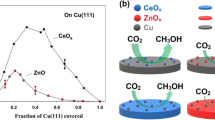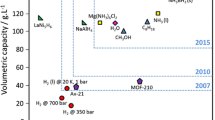Abstract
The effect of ruthenium content on the reductive activation of the Co/δ-Al2O3 catalyst was investigated using thermal analysis and in situ synchrotron radiation X-ray diffraction. Data of thermal analysis and phase transformations can be described by a kinetic scheme consisting of three sequential steps: Co3+ → Co2+ → (Co0Co2+) → Co0. The first step is the generation of several CoO clusters within one Co3O4 crystallite followed by their further growth obeying the Avrami–Erofeev kinetic equation (An1) with dimensional parameter n1 < 1, which may indicate the diffusion control of the growth. The second step is the kinetically controlled sequential process of the metallic cobalt phase nucleation (An2), which is followed by the third step of slow particle growth limited by mass transport according to the Jander model (D). Ruthenium promotion of Co/δ-Al2O3 catalysts significantly accelerates the reduction of cobalt. As the ruthenium content is raised to 1 wt%, the characteristic temperature of metal phase formation decreases by more than 200 °C and Ea for An2 step decreases by 25%. For step D, a joint decrease in activation energy and pre-exponential factor in case of ruthenium promotion corresponds to a weaker diffusion impediment at the final step of cobalt reduction. In the case of unmodified Co/δ-Al2O3, the characteristic temperature of the metal phase formation reaches very high values, the metallic nuclei rapidly coalesce into larger ones, and the further process is inhibited by diffusion of the reactants through the product layer. For ruthenium promoted catalysts, each CoO crystallite generates one metal crystallite; thus, ruthenium enhances the dispersion of the active component.





Similar content being viewed by others
References
Jacobs G, Ji Y, Davis BH, Cronauer D, Kropf AJ, Marshall ChL (2007) Fischer-Tropsch synthesis: temperature programmed EXAFS/XANES investigation of the influence of support type, cobalt loading and noble metal promoter addition to the reduction behavior of cobalt oxide particles. Appl Catal A 333:177–191
Bulavchenko OA, Cherepanova SV, Malakhov VV, Dovlitova LS, Ishchenko AV, Tsybulya SV (2009) In situ XRD study of nanocrystalline cobalt oxide reduction. Kinet Catal 50:192–198
Simentsova II, Khassin AA, Minyukova TP, Davydova LP, Shmakov AN, Bulavchenko OA, Cherepanova SV, Kustova GN, Yurieva TM (2012) The effect of composition and structure of a precursor compound on the catalytic properties of cobalt-aluminum catalysts in Fischer-Tropsch reactions. Kinet Catal 53(4):520–526
Hong J, Marceau E, Khodakov AYu, Gaberová L, Griboval-Constant A, Girardon JS, La Fontaine C, Briois V (2015) Speciation of ruthenium as a reduction promoter of silica-supported Co catalysts: a time-resolved in situ XAS investigation. ACS Catal 5:1273–1282
Potoczna-Petru D, Kępiński L (2001) Reduction study of Co3O4 model catalyst by electron microscopy. Catal Lett 73:41–46
Ward MR, Boyes ED, Gai PL (2013) In situ aberration-corrected environmental TEM: reduction of model Co3O4 in H2 at the atomic level. ChemCatChem 5:2655–2661
Reueland R, Bartholomew CH (1984) Effects of support and dispersion on the CO hydrogenation activity/selectivity properties of cobalt. J Catal 85:78–88
Arnoldy P, Moulijn JA (1985) Temperature-programmed reduction of CoO/Al2O3 catalysts. J Catal 93:38–54
Hansteen OH, Fjellvag H, Hauback BC (1998) Reduction, Crystal Structure and Magnetic Properties of Co(3−x)Al(x)O(4-delta) (0.0<=X<=2.0, 0.0<=delta<=1.0). Comparison with the Co/gamma-Al2O3 Fischer-Tropsch catalyst. Acta Chem Scand 52:1285–1292
Khassin AA, Anufrienko VF, Ikorskii VN, Plyasova LM, Kustova GN, Larina TV, Molina IYu, Parmon VN (2002) Physico-chemical study on the state of cobalt in a precipitated cobalt-aluminum oxide system. Phys Chem Chem Phys 4:4236–4243
Tsakoumis NE, Rønning M, Borg Ø, Rytter E, Holmen A (2010) Deactivation of cobalt based Fischer-Tropsch catalysts: a review. Catal Today 154:162–182
Jacobs G, Sarkar A, Ji Y, Luo M, Dozier A, Davis BH (2008) Fischer-Tropsch synthesis: assessment of the ripening of cobalt clusters and mixing between Co and Ru Promoter via oxidation–reduction-cycles over lower Co-loaded Ru–Co/Al2O3 catalysts. Ind En Chem Res 47(3):672–680
Khodakov AYu, Lynch J, Bazin D, Rebours B, Zanier N, Moisson B, Chaumette P (1997) Reducibility of cobalt species in silica-supported Fischer-Tropsch catalysts. J Catal 168:16–25
Tsubaki N, Sun S, Fujimoto K (2001) Different functions of the noble metals added to cobalt catalysts for Fischer-Tropsch synthesis. J Catal 199:236–246
Ma W, Jacobs G, Keogh RA, Bukur DB, Davis BH (2012) Fischer-Tropsch synthesis: effect of Pd, Pt, Re, and Ru noble metal promoters on the activity and selectivity of a 25%Co/Al2O3 catalyst. Appl Catal A 437–438:1–9
Jacobs G, Patterson PM, Zhang Y, Das T, Li J, Davis BH (2002) Fischer-Tropsch synthesis: deactivation of noble metal-promoted Co/Al2O3 catalysts. Appl Catal A 233:263–281
Song S-H, Lee S-B, Bae JW, Sai Prasad PS, Jun K-W (2008) Influence of Ru segregation on the activity of Ru–Co/γ-Al2O3 during FT synthesis: a comparison with that of Ru–Co/SiO2 catalysts. Catal Commun 9:2282–2286
Kogelbauer A, Goodwin JG Jr, Oukaci R (1996) Ruthenium promotion of Co/Al2O3 Fischer Tropsch catalysts. J Catal 160:125–133
Park J-Y, Lee Y-J, Karandikar PR, Jun K-W, Bae JW, Ha K-S (2011) Ru promoted cobalt catalyst on γ-Al2O3 support: influence of pre-synthesized nanoparticles on Fischer-Tropsch reaction. J Mol Catal A 344:153–160
Parnian MJ, Najafabadi AT, Mortazavi Y, Khodadadi AA, Nazzari I (2014) Ru promoted cobalt catalyst on γ-Al2O3: influence of different catalyst preparation method and Ru loadings on Fischer-Tropsch reaction and kinetics. Appl Surf Sci 313:183–195
Cook KM, Poudyal S, Miller JT, Bartholomew CH, Hecker WC (2012) Reducibility of alumina-supported cobalt Fischer-Tropsch catalysts: effects of noble metal type, distribution, retention, chemical state, bonding, and influence on cobalt crystallite size. Appl Catal A 449:69–80
Hilmen AM, Schanke D, Holmen A (1996) TPR study of the mechanism of rhenium promotion of alumina-supported cobalt Fischer-Tropsch catalysts. Catal Lett 38:143–147
Nabaho D, Niemantsverdriet JW, Claeys M, van Steen E (2016) Hydrogen spillover in the Fischer-Tropsch synthesis: an analysis of platinum as a promoter for cobalt–alumina catalysts. Catal Today 261:17–27
Beaumont SK, Alayoglu S, Specht C, Michalak WD, Pushkarev VV, Guo J, Kruse N, Somorjai GA (2014) Combining in situ NEXAFS spectroscopy and CO2 methanation kinetics to study Pt and Co nanoparticle catalysts reveals key insights into the role of platinum in promoted cobalt catalysis. J Am Chem Soc 136:9898–9901
Jacobs G, Chaney JA, Patterson PM, Das TK, Maillot JC, Davis BH (2004) Fischer-Tropsch synthesis: study of the promotion of Pt on the reduction property of Co/Al2O3 catalysts by in situ EXAFS of Co K and Pt LIII edges and XPS. J Synchrotron Radiat 11:414–422
Iglesia E, Soled SL, Fiato RA, Via GH (1993) Bimetallic synergy in cobalt ruthenium Fischer-Tropsch synthesis catalysts. J Catal 143:345–368
Li P, Liu J, Nag N, Crozier PA (2006) In situ synthesis and characterization of Ru promoted Co/Al2O3 Fischer-Tropsch catalysts. Appl Catal A 307:212–221
Geus JW, van Dillen AJ (2008) In: Ertl G, Knözinger H, Schüth F, Weitkamp J (eds) Handbook of heterogeneous catalysis, 2nd edn. Wiley, New York
Simentsova II, Khassin AA, Filonenko GA, Chermashentseva GK, Bulavchenko OA, Cherepanova SV, Yurieva TM (2011) Anionic composition of precursors of the CO/Al2O3 catalysts for the Fischer-Tropsch synthesis. Russ Chem Bull 60:1827–1834
Khassin AA, Simentsova II, Cherepanova SV, Shmakov AN, Shtertser NV, Bulavchenko OA (2016) Effect of nitric oxide on the formation of cobalt–aluminum oxide structure from layered double hydroxide and its further transformation during reductive activation. Appl Catal A 514:114–125
Kabin EV, Emel’yanov VA, Alferova NI, Tkachev SV, Baidina IA, Vorob’yev VA (2012) Reaction of trans-[RuNO(NH3)4(OH)]Cl2 with nitric acid and synthesis of ammine(nitrato)nitrosoruthenium complex. Russ J Inorg Chem 57:1146–1153
Le Bail A (2005) Whole powder pattern decomposition methods and applications: a retrospection. Powder Diffr 20:316–326
Friedman HL (1969) New methods for evaluating kinetic parameters from thermal analysis data. J Polym Sci Part B 7:41–46
Ozawa T (1965) A new method of analyzing thermogravimetric data. Bull Chem Soc Jpn 38:1881–1886
Flynn J, Wall LA (1966) A quick, direct method for the determination of activation energy from thermogravimetric data. J Polym Sci Part B 4:323–328
Vyazovkin SV (2003) Model-free kinetics. J Therm Anal Calorim 83:45–51
Sun NX, Liu XD, Lu K (1996) An explanation to the anomalous Avrami exponent. Scr Mater 34:1201–1207
Brown ME, Dollimore D, Galwey AK (1980) In: Bamford CH, Tipper CFH (eds) Comprehensive chemical kinetics. Elsevier, Amsterdam
De Bruijn TJW, De Jong WA, Van Den Berg PJ (1981) Kinetic parameters in Avrami–Erofeev type reactions from isothermal and non-isothermal experiments. Thermochim Acta 45:315–325
Vyazovkin S, Wigh CA (1997) Isothermal and nonisothermal reaction kinetics in solids: in search of ways toward consensus. J Phys Chem A 101:8279–8284
Tomic-Tucakovic B, Majstorovic D, Jelic D, Mentus S (2012) Thermogravimetric study of the kinetics of Co3O4 reduction by hydrogen. Thermochim Acta 541:15–24
Ji Y, Zhao Zh, Duan A, Jiang G, Liu J (2009) Comparative study on the formation and reduction of bulk and Al2O3-supported cobalt oxides by H2-TPR technique. J Phys Chem C 113:7186–7199
Lin H-Y, Chen Y-W (2007) The mechanism of reduction of cobalt by hydrogen. Mater Chem Phys 85:171–175
Chu W, Chernavskii PA, Gengembre L, Pankina GA, Fongarland P, Khodakov AY (2007) Cobalt species in promoted cobalt alumina-supported Fischer-Tropsch catalysts. J Catal 252:215–230
Wan YJ, Li JL, Chen DH (2007) Kinetic characterization of the reduction of silica supported cobalt catalysts. J Therm Anal Calorim 90:415–419
Garces LJ, Hincapie B, Zerger R, Suib SL (2015) The effect of temperature and support on the reduction of cobalt oxide: an in situ X-ray diffraction study. J Phys Chem C 119(10):5484–5490
Smith ML, Campos A, Spivey JJ (2012) Reduction processes in Cu/SiO2, Co/SiO2, and CuCo/SiO2 catalysts. Catal Today 182(1):60–66
Liu Y, Luo J, Shin Y, Moldovan S, Ersen O, Hebraud A, Schlatter G, Pham-Huu C, Meny Ch (2016) Sampling the structure and chemical order in assemblies of ferromagnetic nanoparticles by nuclear magnetic resonance. Nat commun. doi:10.1038/ncomms115327
Lok CM (2004) Novel highly dispersed cobalt catalysts for improved Fischer-Tropsch productivity. Stud Surf Sci Catal 147:283–288
Acknowledgements
The research was supported by the joint Research and Educational Center for Energy Efficient Catalysis (Novosibirsk State University and Boreskov Institute of Catalysis SB RAS), by Russian Government Decree No. V.45.3.6. The authors are grateful to Prof. V.A. Emelyanov (Novosibirsk State University) who afforded trans-Ru(NO)(NH3)2(NO3)3 complex for the study and and Dr. I.I. Simentsova who afforded Co–Al–M sample for the study.
Author information
Authors and Affiliations
Corresponding author
Rights and permissions
About this article
Cite this article
Kungurova, O.A., Shtertser, N.V., Koemets, E.G. et al. The effect of ruthenium promotion of the Co/δ-Al2O3 catalyst on the hydrogen reduction kinetics of cobalt. Reac Kinet Mech Cat 120, 501–525 (2017). https://doi.org/10.1007/s11144-016-1118-2
Received:
Accepted:
Published:
Issue Date:
DOI: https://doi.org/10.1007/s11144-016-1118-2




